 Vampire Weekend's Surprising Jewish Stories
Vampire Weekend's Surprising Jewish Stories


4 min read
3 min read
4 min read
15 min read
Delicious crust, fillings and a Purim surprise.
Excerpted from Remaining Kosher Volume Two: A Cookbook for All with a Hechsher in Their Heart. Click here to see the eBook at Apple. Or visit: LaurenStacyBerdy.com.
The celebration of Purim and hamentashen are synonymous. You can’t think of one without the other.
Beans are also on the menu during Purim. I offer these two recipes. Both are intimately rooted in Indian cookery where they know how to charm a pot of beans.
Happy Purim!
 A hamentash is a piece of pastry first and foremost. The dough that forms the famous triangle is just as important as the filling.
A hamentash is a piece of pastry first and foremost. The dough that forms the famous triangle is just as important as the filling.
You want the crust to be notable. Have I got a dough for you!
It is parve, it is easy to work with and it will spark your mouth’s interest.
It is made on the shoulders of the mighty halvah and its cousin tahini. Halvah and tahini have a long storied history of being used in baking.
I would be the last to say that I was an originator. I have just continued that conversation.
Once the dough is made, all those “hats” need filling. Apples, dried figs, prunes and apricots are calling out to me. I answered that call and present my own musings.
Yield: about 45 hamentashen
Special Equipment: bowl, standing mixer and batter attachment, pastry brush, baking sheet, parchment or silpat
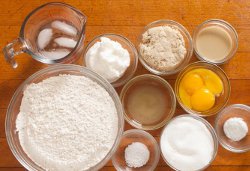
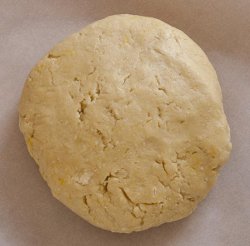
This dough is made in a standing mixer with batter hook attachment.
Prepare the ice water: in a measuring cup, add ½ cup cold tap water and toss in a couple ice cubes. Set aside.
Prime the other ingredients.
Pry the packed, measured halvah out and place into a microwaveable bowl. Microwave for 15 seconds to soften. Set aside.
Sift the flour, baking powder and salt together over the standing mixing bowl.
Place the sugar, egg yolks, softened halvah, tahini, optional lemon zest into the bowl.
Attach the batter hook. On medium speed blend ingredients until crumbs are formed.
Discard the ice and pour off all but a ¼ cup of ice water.
Pour in the water and add in the lemon juice. Blend all the ingredients together just until a dough is formed.
Remove the finished dough. Refrigerate for a couple of hours before use.
This dough can be also be wrapped in parchment and then sealed in plastic this way for three days, or keep frozen for about two weeks.
Line baking pan(s) with silpat mat(s) or parchment paper.
Make the egg wash. Beat the egg and the water together.
Cut the dough in half. Refrigerate other half.
Preheat oven to 350 ºF (convection when available).
On a liberally floured work surface. Roll the dough out to ¼ inch thickness. Dust the surface with flour as necessary.
Use a 3” round cutter or a drinking glass to cut out as many circles as possible. Place the dough circles on the prepared baking pan(s).
Reform scraps and repeat.
Chill the circles until firm – about 30 minutes.
Make more circles with the other half of the dough, or seal and refrigerate or freeze.
Remove the chilled circles from refrigerator. Brush the top of each circle with egg wash.
Place a tablespoon of filling in the center of each circle.
Fold in the sides to form a triangle. Pinch the dough to enclose the filling.
Brush the entire surface of the each pastry with egg wash.
I like to shower each piece with sugar, it adds crunch. It’s up to you.
Bake the pastries in the center rack of the oven until golden brown on the edges. About 20-25 minutes.
Cool on the baking sheets for 5 minutes; then transfer to wire racks to cool completely.
 All fillings easily double.
All fillings easily double.
(yields about 1 cup)
Use a vegetable peeler to zest the tangerine. You want the zest, not the white pith.
Place the peels into a saucepan. Cover the peels with tap water. Bring to a rapid boil then drain. Repeat two more times.
Cut the remaining naked tangerine in half. Squeeze out the juice. You need ¼ cup of juice. Add water if necessary. Set aside.
Place the prunes, tangerine peel, juice and sugar into a microwavable bowl. Seal with plastic wrap.
Cook for 2½ minutes.
Plop and scrape it all into the standing mixer and purée.
Scrape into a jar or container. Refrigerate.
(yields about 1½ cups)
Place the stemmed figs, water and sugar into a microwavable bowl. Seal with plastic wrap. Microwave for 2½ minutes. Remove.
Pluck the optional rose petals.
Scrape cooked figs and all into the standing mixer. Add the rose water or syrup, lemon juice and optional rose petals. Purée. Taste, add more rose water or syrup to suit.
Scrape into a container or lidded jar.
(yields about1½ cups)
Peel, core, slice and dice the apples into smaller pieces – about 4 overflowing cups.
Combine the apples, raisins, water, sugar and cinnamon stick into a sauce pan. Bring to a boil, stirring occasionally until sugar dissolves.
Cover; reduce heat to medium-low and simmer until the apples are very tender while stirring frequently – about 10-15 minutes.
Remove from the heat. Use a potato masher or fork to gently mash apples until mixture is very soft but still chunky. Cool completely.
This filling can be made 2 days ahead: just cover and refrigerate.
(yields about 1 cup)
Preheat toaster oven or oven to 350 ºF.
Toast the bitter almonds for 7 minutes. Remove and set aside.
Combine the apricots, sugar and water in a microwave bowl. Seal with plastic. Microwave for 2½ minutes.
Scrape the cooked apricots into a standing blender. Add in toasted bitter almonds, almond extract and lemon juice. Purée.
Scrape into a container or a lidded jar.
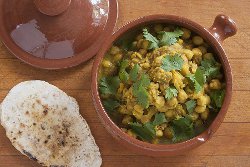 Chickpeas are front and center here. This is an all chickpea stew in really delicious gravy. If you enjoy chickpeas as much as I do, this recipe is unquestionably for you.
Chickpeas are front and center here. This is an all chickpea stew in really delicious gravy. If you enjoy chickpeas as much as I do, this recipe is unquestionably for you.
The mainspring here comes from the comradeship among ingredients.
This stew is an amalgam of Indian tastes and stars a few of that country’s most famous contributions to the cooking pot. These ingredients are considered unique to Indian cooking and are part of the reason why even this simple chickpea stew tastes so lavish.
Front and center is asafetida, derived from the resin of a carrot-like root. It is then dried and powdered – so far, so good.
What I can’t find words to explain is this: asafetida is potent and really odiferous! It has its own language when you open the bottle. Don’t be shy! Get past your inner censor.
Adding a pinch in any oil will infuse the air with the fragrance of cooked onions.
It is your ally! Asafetida has been charming pots of food for thousands of years.
Open the small bottle, take a pinch and use it in this recipe. Store the remainder in a lidded glass jar.
Amchur (mango powder) is simply green mangos that are ground into powder. Amchur adds a sour sparkle. An amusing lemony sour overtone comes with a (just a) pinch or two.
If your first use was to make this recipe, next time sprinkle a pinch of amchur in the fruit salad, or on spinach, or even corn. I like to sprinkle amchur on yogurt and cucumbers.
Both asafetida and mango powder are readably available in any Indian market.
A trip to the most Indian markets is beneficial to your health: the vegetables are gorgeously fresh and the spices typically less expensive. Usually near the door are large sacks of fragrant basmati rice. Buy one!
Or order these spices on line.
All the other ingredients are actors with familiar, worldly roles, all associated with many other cuisines. Every culture knows a good thing once they taste it.
Hate cilantro? Substitute fresh mint.
Chilies are present too. Make this recipe spicy, pulsating – or not. Just remember, chili blooms upon sitting. You can always offer freshly chopped chilies at the table.
Either way, this chickpea stew embodies Mother India.
Yield: 6 servings
Special Equipment: bowl, pasta pot, large saucepan, potato masher, wooden spoon, serving casserole
Wash the beans in several changes of water. Soak overnight in water to cover. Drain the water before using.
or
Cover the dried beans with water and bring to a boil. Cook for 5 minutes. Remove from the burner. Let the beans sit covered for an hour.
Discard the chickpea soaking water. Boil the drained chickpeas in 8 cups of water. Cover and simmer for 2 hours. The chickpeas should easily crush between two fingers. Drain and save 4 cups of the cooking liquid.
Cut the jalapeño in half. Cut half the jalapeño into slices, then chop into tiny pieces. Reserve the other half for the table, if you so choose.
Don’t touch your face or eyes until a thorough washing of your hands with soap.
Heat the oil in a large saucepan over medium heat. Add in the ginger and garlic. Stir and cook for one minute.
Add the cumin seeds and asafetida. Sizzle and stir. Cook for 30 seconds.
Add the drained chickpeas, turmeric, ground coriander, dried mango and jalapeño. Stir fry and cook all the ingredients in the oil for 1 minute.
Add in the saved 4 cups of chickpea broth. Cover and simmer for 20 minutes.
Take off the cover and turn up the heat. Boil and reduce for another 10 minutes. Slide off burner.
Use the potato masher on ¼ of the chickpeas. Knock the masher against the inside of the pan to “clean.”
Taste for seasoning. The broth should be full-bodied. Add salt if needed.
Heat the chickpeas in its own broth.
Add in lemon juice and the cilantro. Taste for salt.
Add more chili (to your taste). Remember, chili “blooms.”
Serve the chickpea stew in a covered casserole.
Chickpea Stew with Ginger can be made a few days before and reheated. Just don’t add the lemon juice or cilantro until you are ready to heat and serve.
I like to serve naan with this recipe.
You can find commercially packaged kosher (with a good hechsher) Indian naan bread off the shelves of many better supermarkets, not to mention all Indian markets...
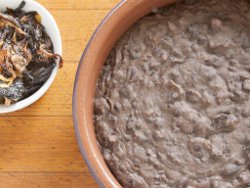 with Slow-Cooked Onions
with Slow-Cooked Onions
This is a delicious, simple vegetarian, one-pot recipe from the accomplished bean cooking land of India. They know many ways to tease out a bean’s taste and texture.
You can parboil the beans and then start cooking within an hour. Or soak the black beans overnight. With either method, the old water gets drained. Adding fresh new water later will make the beans less gaseous!
The black beans and fresh water go into the pot, along with all other ingredients.
Everything gets cook together for about 3-3½ hours. Then the beans get mashed in with a few spoons of both yogurt and butter.
Continued cooking yields the equivalent of Indian “refried beans.” The finished mash has a reddish-brown tint as well.
The beans are good on their own, but the Indians are the ultimate seasoning demons.
The beans will be topped off with slowly fried “chopped liver-style” onions.
This splendid, easy, cooked onion garnish provides the beans an accomplished finale: an invitation to your spoon and your taste buds to partake.
The Indians would cook their onions using ghee. Ghee is butter without milk solids (whey). As a cooking medium and a taste, ghee can’t be duplicated: you get the delicious taste of butter without any burning. Of course, unadulterated butter can be used as well…
Ghee is easy to make and it keeps! And your French toast will never be the same.
A few personal words about how this recipe use chilies: it is not about their heat, it is about the bean.
Almost all beans seem to benefit from a cooking pot “conversation” with some sort of chili. Many cuisines seem to mirror this notion.
The chili is the stage manager and gets to narrate the seasoning action. It’s the “Our Town” of ingredients. While I enjoy a subtle narration, you might like a loud one.
The recipe easily doubles/triples/quadruples/quintuples/sextuples/septuples/octuples...
Yield: 4 servings
Special Equipment: saucepan with cover, frying pan
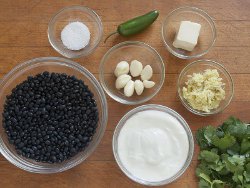
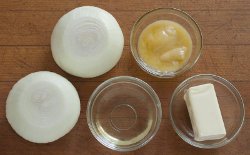
Wash the bean in several changes of water. Soak overnight in water to cover. Drain the water before using.
or
Cover the dried beans with water and bring to a boil. Cook for 5 minutes. Remove from the burner. Let the beans sit covered for an hour.
When to proceed, drain the water out.
Make sure to avoid touching your face or eyes when working with chilies.
Slice the chili in half. Use the amount that makes you feel comfortable. I use 1½” of a jalapeño.
The chilies will be a subtle note in the finished dish. If you want it louder, add more!
Grate the peeled ginger using the large holes of a box grater.
Peel the garlic cloves and smash each clove with the back of a knife.
Place the drained beans, chili, garlic, ginger, salt and measured water into a sauce pan. Bring to a boil.
Bring the heat way down to low. Cover with the lid slightly ajar. Cook for about 3-3½ hours. The beans should easily squish between your fingers.
While beans are cooking, slice the onion in half. Place cut side down and slice into ½” moons.
If using ghee, heat in a frying pan over low heat.
If using butter, add in the vegetable oil over low heat to keep the butter from burning.
Add in the onions.
Adjust the heat to medium low. Stir occasionally.
Fry until the onions start to change color – about 15 minutes
Lower the heat and stir as needed, letting the onions slowly cook for another 15-20 minutes. Some will be darker than others.
After the beans are cooked, slightly mash the beans. I use a potato masher, but a large kitchen spoon will do. Use a large kitchen spoon to press the beans into the sides the cooking pot, mashing them.
Some beans should remain whole, others “mashed.”
Add in the yogurt and butter. Stir. Cook uncovered over low heat for 30 minutes. Occasionally stir the beans as they reduce.
At this point, the beans should be reddish-brown, thick with very little, if any, broth. Continue to cook until the beans bubble slowly like lava inside the pot.


Cover and reheat the beans over low heat, stirring occasionally.
Taste for seasoning. Make sure the beans have enough salt and pepper.
Remember – chilies bloom! They become hotter over time.
Once the beans are sufficiently hot, scrape into a serving dish.
Top the beans with the onions.
Sprinkle with fresh cilantro or mint.
I like to serve naan with this recipe.
You can find commercially packaged kosher (with a good hechsher) Indian naan bread off the shelves of many better supermarkets, not to mention all Indian markets.
Excerpted from Remaining Kosher Volume Two: A Cookbook for All with a Hechsher in Their Heart. Click here to see the eBook at Apple. Or visit: LaurenStacyBerdy.com.
